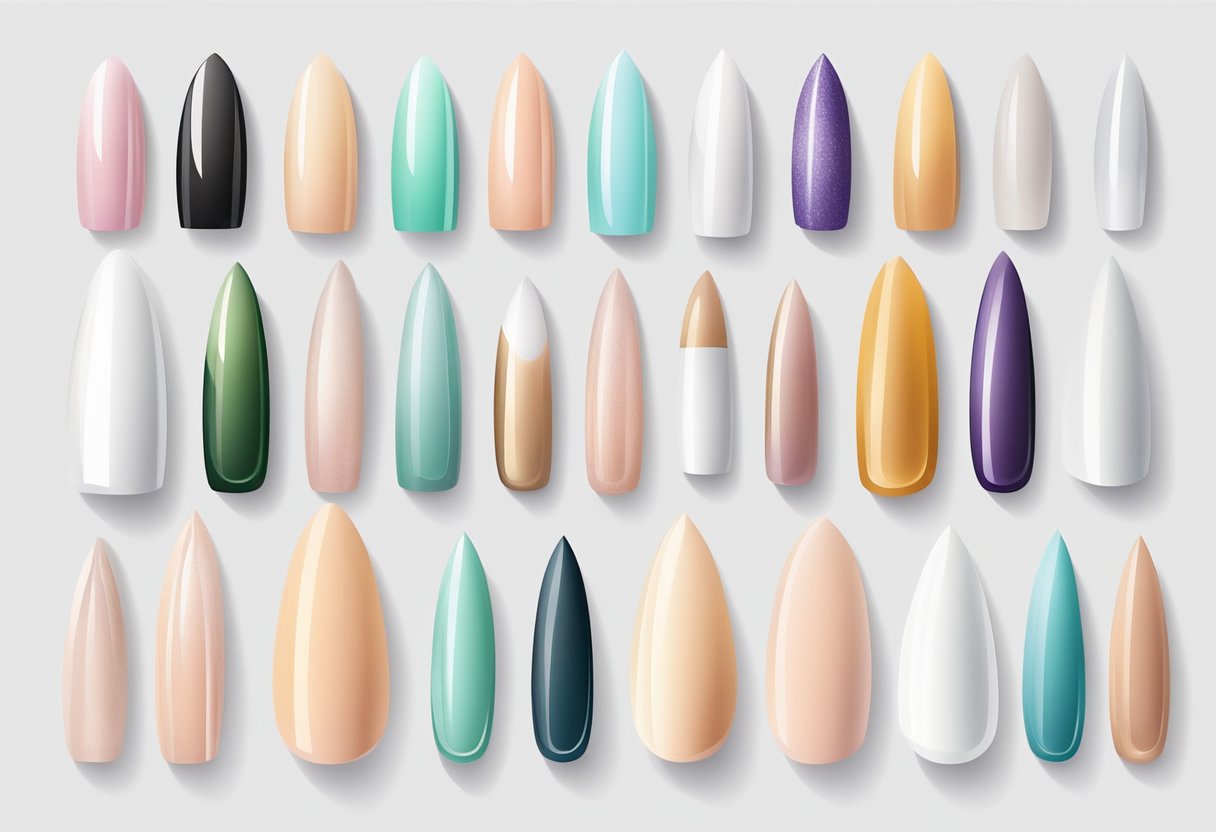Types Of Acrylic Nails
Acrylic nails are one of the most popular types of fake nails that can be applied to natural nails. They can be used to change the shape or length of natural nails, as well as add color and designs. Acrylic nails are made of a combination of liquid and powder that hardens when exposed to air, creating a durable and long-lasting nail.

There are several different types of acrylic nails, including sculpted, gel, and wrap. Sculpted acrylic nails are created by applying a ball of acrylic mixture to the nail and shaping it with a brush. Gel acrylic nails are made by mixing a gel with the acrylic mixture, which creates a more flexible and natural-looking nail. Wrap acrylic nails are made by wrapping a piece of silk or fiberglass around the natural nail and applying the acrylic mixture over it.
Understanding the different types of acrylic nails and their application process can help you choose the right type for your needs. It is important to consider factors such as the shape, length, and design of the nail, as well as the maintenance and care required to keep the nails looking their best. With the right knowledge and tools, you can achieve beautiful and long-lasting acrylic nails that enhance your natural beauty.
Key Takeaways
- Acrylic nails are a popular type of fake nail that can be applied to natural nails to change their shape, length, and design.
- There are several different types of acrylic nails, including sculpted, gel, and wrap, each with their own unique application process and benefits.
- Understanding the different types of acrylic nails and their maintenance and care requirements can help you choose the right type for your needs and achieve beautiful and long-lasting results.
Understanding Acrylic Nails
Acrylic nails are a popular type of nail enhancement that can be added to natural nails to create a longer and more durable manicure. They are made from a combination of acrylic powder and liquid monomer, which are mixed together to create a thick paste that can be applied to the natural nail.
Acrylic Powder and Liquid Monomer
Acrylic powder and liquid monomer are the two main components used to create acrylic nails. The powder is made from a polymer that is mixed with a liquid monomer to create a thick paste. The paste is then applied to the natural nail and sculpted into the desired shape using a brush.
The Acrylic Manicure Process
Acrylic nails are typically applied by a nail technician at a nail salon. The process typically involves the following steps:
-
The natural nails are cleaned and prepped for the acrylic application. This may involve trimming, filing, and buffing the nails to create a smooth surface.
-
A nail form is applied to the base of the natural nail to create a guide for the acrylic application.
-
The nail technician mixes the acrylic powder and liquid monomer together to create a thick paste.
-
The paste is applied to the natural nail and sculpted into the desired shape using a brush.
-
The acrylic is allowed to dry and harden.
-
The nails are filed and buffed to create a smooth surface.
-
The nails are polished with a topcoat to add shine and protect the acrylic.
It is important to note that while acrylic nails can be a durable and long-lasting manicure option, they do require regular maintenance and upkeep to prevent damage to the natural nail beds. It is recommended to have acrylic nails removed and reapplied every 2-3 weeks to prevent lifting and other issues.
Popular Acrylic Nail Shapes
When it comes to acrylic nails, there are many different shapes to choose from. The shape of the nail can have a big impact on the overall look of the manicure, so it’s important to choose the right shape for your personal preference.
Round and Oval Nails
Round and oval nails are classic and timeless shapes that are perfect for those who prefer a more natural look. These shapes are also great for those with shorter nails, as they can help to elongate the fingers. Round nails are shaped into a perfect circle, while oval nails are slightly tapered at the tips.
Square and Squoval Nails
Square and squoval nails are popular choices for those who prefer a more modern and edgy look. Square nails are flat on top with sharp corners, while squoval nails are a combination of square and oval, with a slightly rounded tip. These shapes are great for those with longer nails, as they can help to make the fingers appear slimmer.
Almond and Coffin Nails
Almond and coffin nails are both elegant and sophisticated shapes that are perfect for special occasions. Almond nails are tapered at the tips and resemble the shape of an almond, while coffin nails are similar in shape but have a flat tip. These shapes are great for those with longer nails, as they can help to make the fingers appear more slender.
Stiletto and Ballerina Nails
Stiletto and ballerina nails are dramatic and daring shapes that are perfect for those who want to make a statement. Stiletto nails are pointed and resemble the shape of a stiletto heel, while ballerina nails are similar in shape but have a squared-off tip. These shapes are great for those with longer nails, as they can help to elongate the fingers even further.
Ultimately, the choice of nail shape comes down to personal preference and the length of your nails. It’s important to choose a shape that complements your fingers and makes you feel confident and beautiful.
Acrylic Nail Designs and Art
Acrylic nails are a popular option for those who want to add length and strength to their natural nails. However, they are not just for practical purposes. Acrylic nails can also be a canvas for creativity, allowing individuals to express their personal style through nail art and designs.
Color and Polish Options
When it comes to color and polish options for acrylic nails, the possibilities are endless. From classic reds and pinks to trendy pastels and neons, there is a shade to suit every taste. Some popular options include:
- Metallics: Gold, silver, and rose gold can add a touch of glamour to any acrylic nail design.
- Glitter: Whether it’s chunky or fine, glitter can add sparkle and shine to any nail look.
- Matte: For a more understated look, matte polish can create a velvety finish that is both chic and modern.
- Ombre: This gradient effect can be achieved with multiple shades of the same color or contrasting colors for a bold statement.
Embedded Designs and Textures
In addition to polish, acrylic nails can also incorporate embedded designs and textures for a unique look. Some popular options include:
- Rhinestones: These tiny gems can be added in various patterns and colors for a touch of bling.
- Studs: Similar to rhinestones, studs can add texture and dimension to acrylic nails.
- 3D Designs: From flowers to bows, 3D designs can be created with acrylic powder for a whimsical touch.
- Marble: This swirling effect can be achieved with a special technique that creates a marble-like pattern on the nails.
Celebrity manicurists have also popularized certain nail art trends, such as negative space designs and geometric shapes. However, it’s important to note that not all designs may be suitable for everyone’s lifestyle or personal taste. It’s always best to consult with a professional nail technician to determine the best options for your acrylic nail design.
Maintenance and Care of Acrylic Nails
Acrylic nails require regular maintenance and care to ensure they last longer and remain durable. Here are some tips to help you keep your acrylic nails in good condition.
Regular Filling and Upkeep
Filling your acrylic nails is essential to keep them looking fresh and healthy. You should get your nails filled every two to three weeks, depending on how fast your nails grow. Regular filling will help prevent lifting and breakage of the nails.
During the filling process, the nail technician will remove the lifted or damaged part of the acrylic nail and fill it with new acrylic. This process will help to keep the nails looking neat and tidy.
Managing Breakage and Lifting
If you experience breakage or lifting of your acrylic nails, it is essential to address the issue as soon as possible. Leaving the nails in this condition can cause further damage or even lead to infections.
To manage breakage, you can apply nail glue to the affected area and gently press the nail back into place. If the lifting is severe, you may need to visit a nail technician to have the nail removed and replaced.
It is also essential to avoid picking or pulling at the lifted or broken nails, as this can cause further damage. Instead, use a nail file to smooth out any rough edges or snags.
Removing Acrylic Nails
When it comes to removing acrylic nails, it is essential to do it carefully to avoid damaging your natural nails. The best way to remove acrylic nails is to soak them in acetone for 10 to 15 minutes.
After soaking, gently remove the acrylic nails using a wooden stick or cuticle pusher. Avoid using metal tools, as they can damage the natural nails.
It is also essential to take a break from nail enhancement for a few weeks to allow your natural nails to recover from any damage caused by the acrylic nails.
Manicures and Gel Polish
Regular manicures are essential to keep your acrylic nails looking neat and tidy. You can also apply gel polish to your acrylic nails to add some color and shine.
However, it is essential to avoid exposing your nails to UV light for an extended period, as this can damage the acrylic nails. You can protect your nails by applying a layer of sunscreen or wearing gloves while under UV light.
In conclusion, with proper care and maintenance, acrylic nails can last for several weeks. It is essential to follow the tips outlined above to ensure your nails remain healthy and beautiful.
Health and Safety Considerations
Acrylic nails are a popular way to enhance the natural look of nails. However, it is important to take proper health and safety precautions when using them. Here are some tips to help you avoid infections and damage to your natural nails.
Avoiding Infections and Damage
When using acrylic nails, it is important to keep your natural nails and nail bed healthy. This can be achieved by keeping your nails clean and dry, avoiding harsh chemicals, and using nail products sparingly. It is also important to avoid using nail clippers or other tools that can damage your natural nails.
Additionally, it is important to properly remove acrylic nails to avoid damaging your natural nails. Soaking your nails in acetone and gently scraping off the acrylic is the best way to remove them. Never force or pull off the acrylic nails as this can damage your natural nails.
Proper Removal Techniques
Proper removal techniques are crucial to avoid damaging your natural nails. It is recommended to soak your nails in acetone for about 10 minutes to loosen the acrylic from your natural nails. Using an orange wood stick or a cuticle pusher, scrape off the softened acrylic from each nail slowly and gently.
It is important to avoid using harsh chemicals or filing your nails too aggressively, as this can make your nails brittle and prone to damage. Additionally, it is important to keep your nails clean and dry to avoid infections.
By following these tips, you can safely and effectively use acrylic nails to enhance the natural look of your nails. Remember to always prioritize your health and safety when using nail enhancement products.






